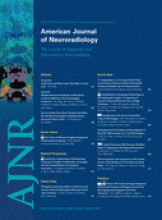Abstract
BACKGROUND AND PURPOSE: The diagnosis of intracranial DAVF with noninvasive cross-sectional imaging such as CTA is challenging. We sought to determine the sensitivity and specificity of CTA compared with cerebral angiography for DAVF in patients presenting with PT.
MATERIALS AND METHODS: Following approval of the institutional review board, we reviewed all patients who underwent CTA for PT from 2004 to 2009 and collected clinical and imaging data. Seven patients with PT and proved DAVF and 7 age- and sex-matched control patients with PT but no DAVF composed the study group. CTA images were blindly interpreted by 2 experienced neuroradiologists for the presence of 5 variables: asymmetric arterial feeding vessels, “shaggy” appearance of a dural venous sinus, transcalvarial venous channels, asymmetric venous collaterals, and abnormal size and number of cortical veins. Asymmetric attenuation of jugular veins was additionally assessed.
RESULTS: The presence of arterial feeders showed good test characteristics for screening, with a sensitivity of 86% (95% CI, 42–99) and a specificity of 100% (95% CI, 52–100). A shaggy sinus or tentorium was highly specific: sensitivity of 42% (95% CI, 11–79) and specificity of 100% (95% CI, 56–100). The presence of transcalvarial venous channels demonstrated a poor sensitivity of 29% (95% CI, 5–70) but a high specificity 86% (95% CI, 42–99). CT attenuation of the jugular veins showed statistically significant asymmetry in the DAVF group versus the control group (P < .05).
CONCLUSIONS: CTA can be used to screen for DAVF in patients with PT. The presence of asymmetrically visible and enlarged arterial feeding vessels has a high sensitivity and specificity for the diagnosis of DAVF.
Abbreviations
- APA
- ascending pharyngeal artery
- CI
- confidence interval
- CTA
- CT angiography
- CTV
- CT venography
- DAVF
- dural arteriovenous fistula
- DSA
- digital subtraction angiography
- dx
- diagnosis
- IJV
- internal jugular vein
- L
- left
- MHT
- meningohypophyseal trunk
- MIP
- maximum intensity projection
- MM
- middle meningeal artery
- MRA
- MR angiography
- MRV
- MR venography
- NPV
- negative predictive value
- Occ
- occipital artery
- PAur
- posterior auricular artery
- PCA
- posterior communicating artery
- PPV
- positive predictive value
- PT
- pulsatile tinnitus
- R
- right
- Vert
- vertebral artery
- Copyright © American Society of Neuroradiology







